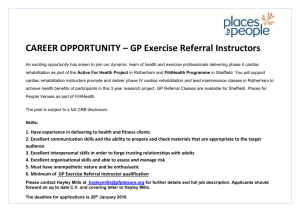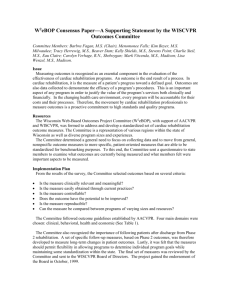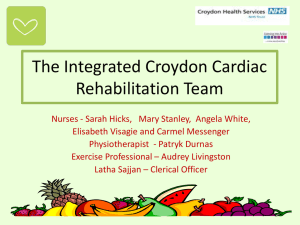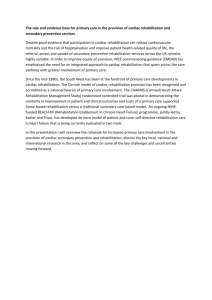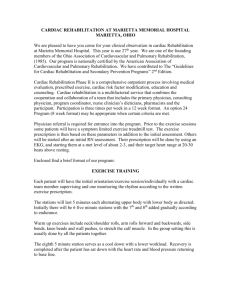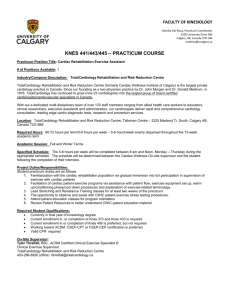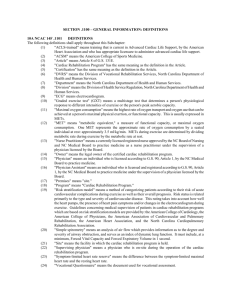The Heart Guide Aotearoa (HGA) Programme
advertisement
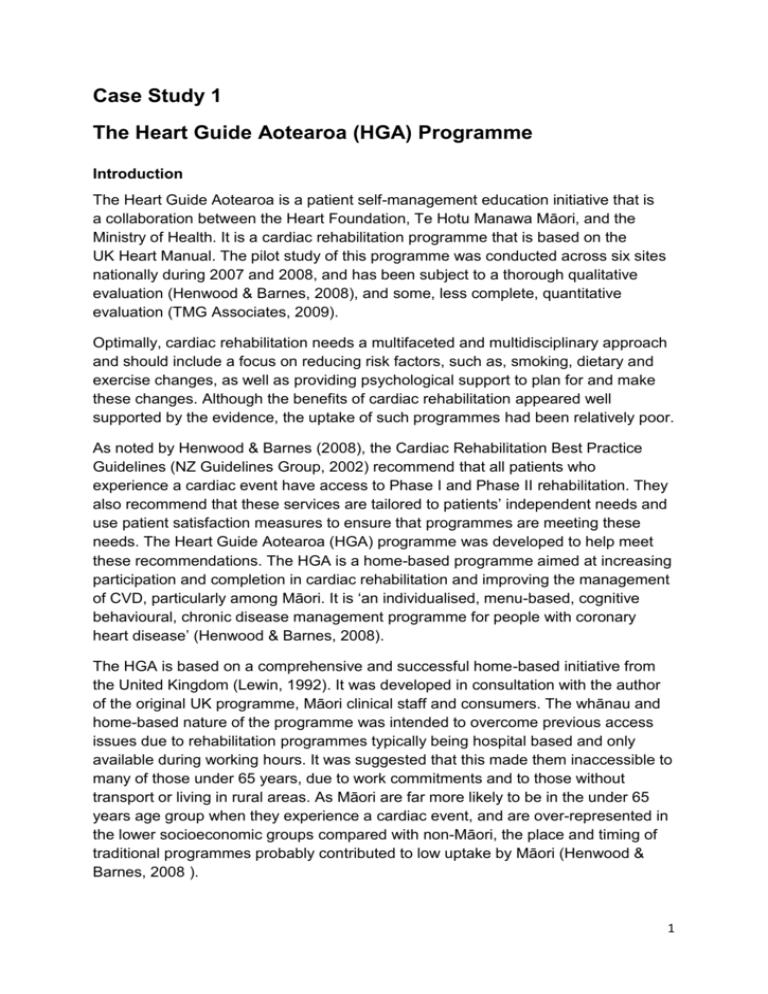
Case Study 1 The Heart Guide Aotearoa (HGA) Programme Introduction The Heart Guide Aotearoa is a patient self-management education initiative that is a collaboration between the Heart Foundation, Te Hotu Manawa Māori, and the Ministry of Health. It is a cardiac rehabilitation programme that is based on the UK Heart Manual. The pilot study of this programme was conducted across six sites nationally during 2007 and 2008, and has been subject to a thorough qualitative evaluation (Henwood & Barnes, 2008), and some, less complete, quantitative evaluation (TMG Associates, 2009). Optimally, cardiac rehabilitation needs a multifaceted and multidisciplinary approach and should include a focus on reducing risk factors, such as, smoking, dietary and exercise changes, as well as providing psychological support to plan for and make these changes. Although the benefits of cardiac rehabilitation appeared well supported by the evidence, the uptake of such programmes had been relatively poor. As noted by Henwood & Barnes (2008), the Cardiac Rehabilitation Best Practice Guidelines (NZ Guidelines Group, 2002) recommend that all patients who experience a cardiac event have access to Phase I and Phase II rehabilitation. They also recommend that these services are tailored to patients’ independent needs and use patient satisfaction measures to ensure that programmes are meeting these needs. The Heart Guide Aotearoa (HGA) programme was developed to help meet these recommendations. The HGA is a home-based programme aimed at increasing participation and completion in cardiac rehabilitation and improving the management of CVD, particularly among Māori. It is ‘an individualised, menu-based, cognitive behavioural, chronic disease management programme for people with coronary heart disease’ (Henwood & Barnes, 2008). The HGA is based on a comprehensive and successful home-based initiative from the United Kingdom (Lewin, 1992). It was developed in consultation with the author of the original UK programme, Māori clinical staff and consumers. The whānau and home-based nature of the programme was intended to overcome previous access issues due to rehabilitation programmes typically being hospital based and only available during working hours. It was suggested that this made them inaccessible to many of those under 65 years, due to work commitments and to those without transport or living in rural areas. As Māori are far more likely to be in the under 65 years age group when they experience a cardiac event, and are over-represented in the lower socioeconomic groups compared with non-Māori, the place and timing of traditional programmes probably contributed to low uptake by Māori (Henwood & Barnes, 2008 ). 1 The HGA is a programme that attempts to redress these inequities and make cardiac rehabilitation more broadly available to those who may not otherwise access it, by providing the service in the patient’s own home. Aims of the project The Aim of the project was to pilot a cardiac rehabilitation model that would meet patients’ needs within their own environment. ‘Also to provide a model of care that would help change clinician practice....consciously set out a model to guide care that will change practice.’ What were the business drivers that prompted changes to service delivery? What were the other key drivers? It was noted that the number of people completing cardiac rehabilitation was small, although this intervention is associated with a reduction in mortality of 25% to 30%. This is a substantial return for a relatively low-intensity programme. Increasing the uptake and completion of cardiac rehabilitation was a key driver. In New Zealand, where cardiac rehabilitation has traditionally been delivered in a secondary care setting, a national audit in 2002 reported referral rates to rehabilitation as 30% with a completion rate of just 9% for a four session class-based programme (Doolan-Noble et al 2004). The uptake of traditional cardiac rehabilitation is particularly low among Māori, so another of the key drivers of the project was the issue of equity. ‘So how can you make available to Māori an intervention that is going to improve their health outcomes?’ Setting The pilot was conducted across six sites nationally. The six sites were: 1. Southland District Health Board; Southland Hospital, Invercargill 2. Central Otago; Central Otago Health Services Ltd 3. Christchurch; Christchurch Hospital and Pegasus Health 4. Counties Manukau District Health Board; Te Kupenga Hauora o Hoturoa 5. Waitemata Health District Health Board; Te Whānau o Waipareira Trust 6. Te Tai Tokerau Northland A total of 413 participants consented to take part in the evaluation. 2 Existing model of services delivery The existing model of service delivery nationally was a six to 12 week programme of didactic information-giving, provided in secondary care and in a group format. These programmes consist of a series of fixed content education sessions that are strongly medically-oriented and focus on disease information and risk factors. There is little flexibility to tailor the content to individual needs. ‘Although the <(NZ Cardiac Rehabilitation> guidelines state “promote individualised care”, individualised care was very seldom operationalised.’ The lack of personalisation is thought to be a factor in the high drop-out rate of existing group-delivered cardiac rehabilitation. Self-management intervention The HGA programme runs over 6 weeks and involves four contacts; two face-to-face and two by telephone. The first; a home visit, 45–60 minute assessment Week 1; brief follow up and review (by telephone) Week 3; brief follow-up and review (by telephone) Week 6; final face-to-face meeting, review and maintenance. The Heart Guide Aotearoa resources are a package comprising the following material: The Heart Guide Aotearoa Part 1; the basic booklet for the patient The Heart Guide Aotearoa Part 2; additional information for patients to select Information is from The Heart Guide Aotearoa Partner and Family/Whānau; information Specifically focussed on family members A relaxation tape/CD A pocket diary; for recording goals, medications and daily activities Assessment questionnaires and audit; the Hospital Anxiety and Depression Scale2, the Dartmouth Co-op Quality of Life3 (QOL), and Cardiac Beliefs The intervention was based on cognitive behavioural principles, thus going beyond simple clinical information-giving. It included personalised assessment, goal setting, problem solving, self-monitoring, action planning, relaxation training and correction of faulty health beliefs. It includes a focus on changing clinicians’ communication styles; facilitators gave greater personal support, were more responsiveness to client needs, and worked to empower clients to self-manage and take control of their own health. 3 The general approach taken by the facilitators was designed to be one of individual support, responsiveness to client needs, and empowerment of clients to self-manage and take control of their own health. Roles taken by various parties to initiate and manage the new delivery model The project was initiated and managed by senior staff at the Heart Foundation, and was developed in partnership with Te Hotu Manawa Māori and the Ministry of Health. It took several years to set up and get underway and involved a full-time project officer based at the Heart Foundation for three years. Funding for development of the programme came principally from the Heart Foundation. Implementation was managed at the DHB and PHO level. Ongoing costs (eg. for copies of resources) are borne by the local providers. Skills and methods of the leaders ‘Tenaciousness. The passion of the local pilots and the people that were involved in it. And commitment.’ (Health manager) Training and qualifications of staff and additional training Staff delivering the programme came from a variety of backgrounds including senior cardiac nurse specialists, community nurses, and a range of non-nursing health professionals. The intensity of training varied across the sites, but the core HGA training was a minimum of two days. Barriers and facilitators to implementation of the programme Facilitators The fact that the programme focussed on cardiovascular disease, which is wellknown to be associated with high levels of mortality and morbidity, assisted the profile of the project. ‘It is perhaps much easier to engage health professionals with “heart” issues than maybe with some other areas,’ (Health manager) A key facilitator was that the project’s approach to delivering SME was novel and was focussed toward health inequalities, which opened funding doors that may not otherwise have been available. Engagement with health managers was made easier by the fact that research clearly showed that the existing model of service delivery was not working. The home visit was a key aspect of the HGA delivery. It created an environment conducive to developing rapport between the facilitator and the client, and an 4 opportunity for observations that helped in understanding the client’s priorities. Participants gave consistent positive feedback on this: ‘I couldn’t drive then. I still can’t but, you know, it was a help for her to be able to come here and she also, you know, included my husband.’ (Client) ‘Well it was great to have them come to me....it felt good....more personal, I suppose.’ (Client). Barriers Cardiac rehabilitation has traditionally been seen as the domain of secondary care. This programme, with its different model of care, and being placed in primary care, was seen by some as a threat. There were elements of turf protection. The existing funding model for cardiac rehabilitation places the budget in secondary care, so it is not clear how the new model would be sustainably funded. There were some difficulties with consistency of referrals and formal relationships between primary and secondary care. Willingness to refer to the HGA was largely dependent on relationships and understanding that referral agents had with HGA providers. The lag time between the provision of training and implementation of the programme was a barrier. Several delays in the roll-out of the programme meant that in some cases months passed between facilitator training and the beginning of implementation of the programme. This negatively affected facilitator confidence and engagement. Notable successes and failures Successes The uptake of the programme by Māori and people in rural areas was a notable success of the programme. ‘I was pretty excited with the <excellent> Māori uptake, and that was a key driver.’ ‘In Central Otago, <engaging> geographically spread men and women who wouldn’t have had <access to> cardiac rehab at all.’ One site in particular was particularly successful in that it supported facilitators who were able to work with patients across PHOs. ‘The standout site was Counties which increased support from 1 FTE to 3 FTE and supported someone who was working across the PHOs.....was able to take patients from PHOs within the Counties region. That was focussed toward Māori.’ 5 The resources developed for the programme and the content and service delivery model were seen to be successful and valued by patients and facilitators. ‘You can change the way care is delivered if you provide the practical tools by which it is done. Providing the right tool and pitching it at the right level.’ ‘…using key principles of CBT and health belief misconceptions and to simplify them in the way that we teach or provide resources.’ The stand-out success of the programme was the ability of the HGA to capture people who would not otherwise engage with cardiac rehabilitation; to improve access through flexibility and taking the intervention to the patient on their terms. ‘Capturing people that were otherwise difficult to capture; these were people that don’t attend traditional cardiac rehab, because they can’t afford to. Working class men can’t afford to take time off work to attend cardiac rehab...working women don’t come...Māori and Polynesian don’t go. It provided these groups with a service that they wouldn’t otherwise utilise, even if they were offered...This is a phenomenal success.’ Failures A number of issues that were less good may be characterised as failures of training. Ensuring that the facilitators delivered the programme according to the structure and principles prescribed in the manual needed to be emphasised in the training. ‘There was a case where there was an implementation failure where the programme was not delivered according to the structure prescribed by the manual. So there was some failure of training in this case.’ A related issue is that of inappropriate staff selection, given the requirements of a patient-centred approach to the intervention that relies on a particular communication style being used by the facilitator. ‘Engaging some staff who did not embrace the patient-centric model, who did not like implementing the programme, and returned to a didactic style of education so the programme fell by the wayside.’ A failure in some instances was the underutilisation of the patient diary, which is a key aspect of the HGA and a valuable way of engaging the patient. ‘There was too little emphasis on the use of the diaries and getting the health professional to emphasise the importance of their use...The key principle is how the health professional “sells” it and how we reinforce it with training.’ A further perceived failure of the pilot was that the quantitative evaluation took more than 18 months to produce which cost the programme momentum. 6 It was also noted that the programme needed to have established better connections with primary care, both to encourage referral and establish a process for handover of the patient to connect them back into primary care. Process improvement/lessons learned. What would you do differently? While the HGA materials were well received it was noted that they were produced to a high ‘glossy’ standard which made them relatively expensive (approximately $22 per set), and this constituted a barrier to health providers picking it up. The materials could be made less expensive. Spending more time at the outset of the project engaging with primary care and developing connections with specialist cardiologists to build relationships and referral networks would have been useful, and would have aided referral. ‘Spend more time engaging with primary care...developing better connection with primary care.’ ‘On my wish list is to get cardiologists behind it...if a cardiologist refers to the programme there is a many 100s percent increase in uptake.’ A greater focus on appropriate staff recruitment and timely training would have improved the programme. ‘Ensure that the staff recruited are appropriate....that they have embraced the patient-centric model.’ ‘This model belongs in primary care with specialist nurse input. So, let’s build the skill base of practice nurses or nurses that actually work across practices but are part of the practice team...as opposed to a secondary care nurse specialist.’ ‘Ensure that the patient gets integrated back into the service <GP practice>.’ Order of magnitude of resources deployed ‘The whole project cost in the region of $700,000. The Ministry of Health contributed $150,000.’ ‘The ongoing costs <for resources etc> have been borne by local providers... at PHO and DHB level.’ General comments ‘We need to bridge the gap between a totally generic model, which I would consider the flavour at the moment, while at the same acknowledging the needs for specific disease groups.’ ‘At the Long Term Conditions Conference, Ed Wagner’s final comment (and challenge to us) was: you need to develop a New Zealand model that embraces the 7 best of the Stanford, the Flinders, and his model, for yourselves because they have all got strengths but they’ve all got weaknesses, and the individual proponents of those don’t talk about the weaknesses.’ ‘We need to have different models of care to take account of different personalities. Not everyone wants to go to a group.’ 8 Further reading Henwood & Barnes (2008). Heart Guide Aotearoa Evaluation: Final Report. Te Ropu Whariki, Massey University: Auckland TMG Associates (2009). Heart Guide Aotearoa. Pilot Program Final Report. Quantitative Analysis. TMG Associates. 9
